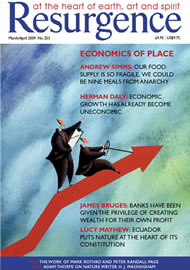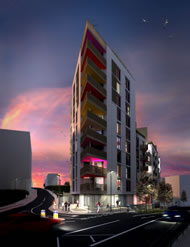DEVELOPERS, PLANNERS AND architects generally don’t consider in any depth the impacts on happiness of what they build, yet it has been proved possible to design housing that maximises residents’ health and happiness whilst minimising their ecological footprint.
Happiness is a surprisingly measurable and reproducible metric. Ask people how happy they are on a score from one to five, and a reliable measure over time and between people can be attained.
Things like good relationships, security in employment, good health and being thankful and compassionate all make us measurably happier. In the past forty years we have doubled our environmental impact, but if anything we are less happy. What lessons can we learn in order to create happier people and places? Designing and fostering neighbourliness appear to be key.
No single factor has affected the shape of our communities more than the car. In shaping our communities, the car has shaped our relationships. Cars connect people over greater distances but disconnect people from their immediate neighbours: there is clear evidence of how roads disrupt communities and local social networks. So creating more mobile and anonymous communities where people don’t know their neighbours has inevitably reduced trust and levels of happiness.
We can build happier communities by shifting to pedestrian- and child-friendly public spaces, creating places where neighbours can meet and mingle. In stark contrast to housing set in a sea of parking, the BedZED eco-village in suburban south London is one place where design around people rather than cars is creating exciting changes. A survey in 2007 showed that a BedZED resident on average knows twenty of his or her neighbours by name, whilst the UK average is closer to three.
The lessons of BedZED inform the One Brighton project being developed by Crest Nicholson plc and BioRegional Quintain and designed by Stirling Award-winning architects Feilden Clegg Bradley Studios. This development of 172 apartments with office and community space is two minutes’ walk from the station, so it has been able to go further than BedZED to create a development that is free of private cars – there are only spaces for car-club vehicles and disabled parking. Creating happier places is not about forcing out cars, but about providing better alternatives such as a car club: serviced, valeted cars which can be booked for use for as little as an hour at a time. Car clubs can save residents money and, with rising motoring costs, we don’t just need affordable homes: we need affordable lifestyles.
Unusual in an apartment scheme, the design at One Brighton incorporates spaces where neighbours can meet, with shared terraces, as well as seating areas in the corridors overlooking shared sky-gardens planted with herbs and vegetables.
Not surprisingly, health and happiness are closely linked. However, as a society we have built places and created lifestyles that do not promote health. Obesity and diabetes are at epidemic levels. Professor Philip James, Chair of the International Obesity Taskforce, calls for towns and cities to be radically redesigned, as planning public spaces around the car is one of the greatest contributors to obesity.
There are also links between food, health and happiness. Psychologist Professor Richard Stevens, as part of a televised experiment called Making Slough Happy, proposed a ten-point plan for happiness, one recommendation being “Plant something and nurture it.” A second recommendation was “Do physical exercise for half an hour three times a week.” One obvious route to increasing happiness is to combine the two and grow more of our own food; hence the incorporation of the rooftop allotments and sky-gardens in the One Brighton project.
Happiness is dependent on a host of other factors, which can be affected by what we design and build: indoor air quality, reducing crime and the fear of crime through mixing homes and workplaces, and reducing the need to commute. It makes sense to take a deliberate approach to creating places where we try systematically to reduce car dependence, increase the probability of knowing our neighbours and increase the amount of local food consumed. It is not possible to guarantee happiness or force residents to be happy, but it is possible to maximise the probability of happiness.








